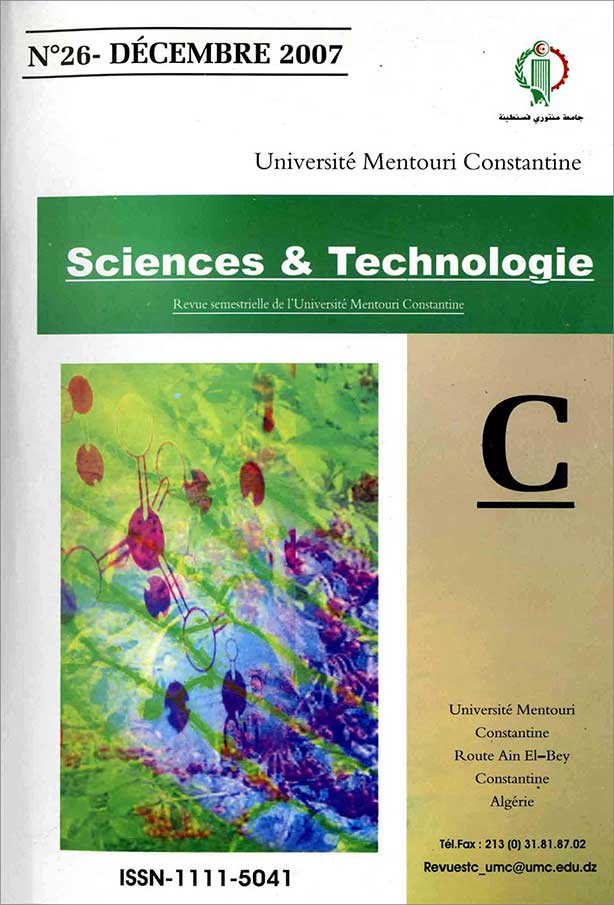REPONSE A LA CULTURE IN VITRO DE TROIS VARIETES DE L’OLIVIER (Olea europaea L.)
Mots-clés :
Olea europaeaL., in vitroculture, Basic medium, growth regulatorsRésumé
The experiment conducted in the Laboratory of Genetic, Biochémistry and plant Biotechnology (LGBBV), Faculty of Sciences, Mentouri University (Constantine) aimed to study the response of three olive cultivars (Olea europaeaL.) response to two basic tissue culture media complemented with different concentrations of growth regulators. Cuttings of Chemlal, Siguoise and Grosse de Hamma cultivars were collected from the Erkani Pilot Farm located at Hamma Bouziane. Under complete aseptic conditions explants 1cm long holding lateral buds were subcultured inMS and B5 media complemented with growth regulators. B5 medium emerged as the best for tissue culture of the studied cultivars. Based on leaf proliferation, stem extension and accumulated fresh matter measurements, Chemlal showed a good response to in vitro culture. Root proliferation was induced after callus formation for Chemlal in the 1/2 diluted MS medium complemented with 0.5 mg.l-1 Kinetine + 0.5 mg.l-1ANA and in B5 medium complemented with 0.4 mg.l-1BAP + 1.33 mg.l-1AIB. And for Sigoise in the 1/2 diluted MS medium complemented with 0.5mg.l-1Kinetine + 1 mg.l-1ANA. Leafed and rooted explants from the two cultivars have passed successfully the acclimation phase and fully adapted to grow under glasshouse conditions.Références
-MA. “Conférence nationalede la consultation sur l’agriculture”. Document Techniquedu Ministère de l’Agriculture
(1992), pp 192.
- Bartolini G., Leva AR., Bonelli A. “ Advances in vitroculture of olive : propagation of CV. Maurino”.Acta Hort.286 (1989), pp 41-44.
-Berenguer B., Gonzalez G. “Ressources génétiques.Actes du
séminaire international sur les innovations scientifiques et leur
application en oleiculture et oleitechnie” Cité par cimmato 10-12
Mars (1999). Florences Italie : Conseil international(1989), pp1-30.
-Leva AR., Petrucceli R. Goretti., Paniccuci M. “ Ruolo di alcuni microelementie carboidrati nella proleferazione in vitro di CV Di olivo (Olea europeaeL.), in Atti quatita olio extravergine di oliva”, Firenze, 1-3 Décembre, (1992), p 333.
-Rugini E. “ In vitropropagation of some olive (Olea europeaeL.) Cultivars with différent root-ability, and medium
developpement using analytical data from developing shoot and
embryo”. Sci Hortic, 24 (1984), pp 123-134.
-Porlongis IC., Theoris I., “ Rooting response of juvénile and
adult leafy olive cutting to various factors”. J.Hott.Sci, 51(1)
(1976), pp 31-39.
-Rugini E., “Olive (Olea europeaeL.) In Bajaj YPS. (Ed.). Biotechnology in agriculture and forestry”. Trees I Berlin, Springer-verlag, 5 (1986), pp253-267.
-Najiba B., Abdelhadi A., Dou Elmacane W L., Doha B. “ Effet du milieu de culture sur le microbouturage de l’olivier (Olea
europeae L.) CV.Picholine Marocaine”
.Biotechnol.Agron.Soc.Environ, 7 (3-4) (2003), pp 177-182.
-Sadder MT. “In vitroestablishment of olive (Olea europaea L.) Using still liquid medium and callus culture”. Dirasat Agricultural Sciences, 35 (2002), pp 19-24.
-Rokba ZA., Loxou VK., Lionakis SM. “Regeneration of olive (Olea europaeaL.) In vitro.” In Proc first meeting on biotechnology,Geisenheim, Germany (2000), pp 25-26.
-Kulchetschi L., Harry LS. Yeung EC., Thorpe TA. “In vitro regeneration of pacific silver fir (Abiesamabilis) plantlets and histological analysis oif shoot formation”. Tree physiology,15. (1995), pp 727-739.
-Grant NJ., Hammatt H. “Increasing root and shoot production during micropropagation of cherry and apple rootstocks: Effect of subculture frequency”. Tree physiology,19
(1999), pp 899-903.
-Sanchez MC., San-Jose MC., Ballester A., Vietz AM. “Requirements forin vitrorooting of Quercus roburand Quercus rubra shoots derived from mature trees”. Tree physiology, 16
(1996) pp 672- 680.
-Rugini E., Jacobini A., Bazzoffia A. “A simple in vitro method to avoid initial dark period and to increase rooting in fruit trees”. Acta Hort, 227 (1988), pp 438-440.
-Rugini E., Jacobini A., Lappino M. “Role of basal darkening
and exogenous putrescine treatments on in vitrorooting and on
endegenous polyamine changes indifficult to root woody
species”. Sci. Hort, 51 (1993), pp 66-72.
-Saborio F., Dvorak W., Donahue JK., Thorpe TA. “In vitro
regeneration of plantlets from mature embryos of Pinus ayacahuite”. Tree physiology, 17 (1997), pp 787-796.
-Rama P., Pontikis C. “In vitropropagation of olive (Olea
europaeaL.) Variety Kalamon”. Journal of Horticultural Science,
(1990), pp 347 - 353.
-Rashid HA., Quarashi RJ. “High frequency embryogenic
calls induction and its regeneration in three wheat cultivars”. In
Review of advances in plant biotechnology Mujeeb Kazi and ED
Smith editors, Cimmyt- Irri Editions(1989), pp 205 – 215.
-Bouharmont JA, Dekeyser FD. “In vitroselection for cold
and salt tolerance in rice”. In Review of advances in plant
biotechnology Mujeeb Kazi and EDSmith editors, Cimmyt- Irri
Editions(1989), pp 307 - 313.
